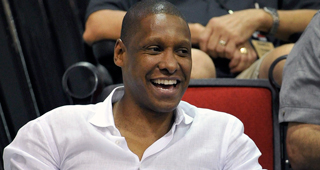With the core of Kyle Lowry, DeMar DeRozan and Jonas Valanciunas, the Toronto Raptors have made the playoffs in each of the last four seasons. The Raptors took a slight step backwards last season, winning five fewer games and exiting in the second round, compared to a Conference Finals appearance in 2016. With four key rotation players facing free agency this summer, the Raptors have to decide if they want to lock into this group. Or was last season a precursor for what’s to come and is it time to move on?
How Toronto got to this spot is an interesting mix of drafts and trades. Last summer, the Raptors had two first round picks and added big men Jakob Poeltl and Pascal Siakam. Both were somewhat confusing choices, but for different reasons. Poeltl was probably the best player available, but he plays the same position as Valanciunas, who was just starting a four-year contract extension. Siakam was considered a reach at the end of the first round when most had him being picked in the second round.
Siakam ended up starting most of the first half of the season, as Toronto preferred to keep Patrick Patterson in a bench role. Poeltl played off the bench behind Valanciunas. As the season progressed, and the Raptors added more talent, both big men ended up seeing more time in the D-League than the NBA. Both have shown promise, but it will also take time for the team to develop them into quality rotation players.
Toronto’s big move over the summer was to re-sign DeRozan to a new contract. DeRozan, who the Raptors drafted with the 9th pick in 2009, signed a five-year contract, but kept it below the maximum salary possible. DeRozan has blossomed into the Raptors' franchise player and leading scorer, despite having an old-school game. He rarely takes three-pointers and relies on scoring in the mid-range or paint and getting to the free throw line. He took a career-high 8.7 free throw attempts per game last season, indicating he still has the explosiveness to get by defenders as he moves into his late 20s.
The Raptors' only free agent addition of note was Jared Sullinger. He signed for the non-taxpayer mid-level exception, but was never really healthy. He played in just 11 games for Toronto before being traded to Phoenix at the deadline.
It was at the aforementioned trade deadline where Masai Ujiri did some of his best work. With a hole at power forward and the need for another wing defender, Ujiri plugged both spots with two trades. First, he sent Terrence Ross and a first round pick to the Orlando Magic to acquire Serge Ibaka. Ibaka started 23 games for the Raptors and gave the team solid rebounding and scoring as a stretch-4 next to Valanciunas.
The second deal saw Sullinger and two second round picks sent to the Phoenix Suns for P.J. Tucker. Tucker primarily came off the bench for Toronto, but supplied the toughness and edge the team had been missing.
The challenge with both trades is that both Ibaka and Tucker were expiring contracts and will be unrestricted free agents this summer. They join a group of free agents that includes Lowry and Patterson. In all, that is two starters and the team’s top two reserves. Without viable backups ready to step in behind them, that puts added pressure on Ujiri to retain each player.
Lowry would seem to be the priority. As much as DeRozan is the team’s franchise player, Lowry is the team’s leader. He has now made three straight All-Star appearances and runs both the offense and defense from his point guard spot. He’s established career-highs in scoring and shooting for each of the last two years. In addition, while Cory Joseph is a fine player as a backup point guard and Delon Wright waits in the wings as the third guy, neither is ready to take over as the starter. This was seen last year when Lowry missed time in both the regular season and the playoffs.
Combine his recent injury history, age (31) and likely contract demands, and you have a question about just how far Toronto should go to retain Lowry. One oft-mentioned suitor was seemingly removed from the market when Philadelphia traded for the #1 overall pick in the draft and will select point guard Markelle Fultz. But Lowry remains an All-Star talent at one of the most important positions in the game. As with most players his age, years are more important than dollars. If Toronto can get Lowry to accept a three year deal at the maximum that would be better than a four or five year deal at slightly less. Lowry gets paid, but the Raptors are protected in case he drops off as he ages.
Ibaka and Tucker are slightly different stories. Ibaka is looking for a big payday, after taking less money in his most recent deal, which was signed with Oklahoma City. He’ll be 28 at the start of next season, and despite concerns about his knees, he’s been healthy the last two seasons. He shot a career-best 39.8 percent from behind the arc after being traded to Toronto and upped his block rate just a bit. Next to the inside presence of Valanciunas, Ibaka gives the Raptors nice balance from the second big position. He’s going to be costly to retain, likely around $20 million average annual value, but Toronto doesn’t really have another option.
Tucker is a defensive specialist, who can guard anywhere from 2-4. He’s also on the older side, as he just turned 32. Never an offensive marvel, he basically takes only three-pointers now and can be a bit streaky. He’ll have options, as teams are always looking for defenders who know their role on offense, but is likely to stay in Toronto on a short team deal that might be a slight overpay to keep him.
That leaves Patterson and he is the most likely to be squeezed out. Ibaka does most of what Patterson can do and does it better. The Raptors still need to find minutes to develop both Poeltl and Siakam. Facing what could be the highest team salary and the largest luxury tax bill in franchise history, someone has to go and that is likely to be Patterson.
Toronto would like to add another wing shooter, which is something they lost when they traded Ross to Orlando. They could use a portion of the non-taxpayer exception to bring in a veteran there. Players like Jodie Meeks, Anthony Morrow or Justin Holiday could all make sense, as they would all be cheap enough and fill the wing shooter role.
You can expect the Toronto Raptors to look fairly similar to the group that ended last season. Barring an unexpected change of heart, they’ll bring back Lowry and Ibaka at least. The challenge isn’t really this next season though, it is further down the line. With DeRozan signed for at least three more years at nearly $28 million per season, Toronto has to be careful about managing their cap sheet. Extending too many years for older players like Lowry, Ibaka or Tucker could put the team in rough shape in a few years as the core ages. Expensive and old is a path towards irrelevance and extinction as a contender.
Offseason Details
Guaranteed Contracts (9): Bruno Caboclo, DeMarre Carroll, DeMar DeRozan, Cory Joseph, Lucas Nogueira, Jakob Poeltl, Pascal Siakam, Jonas Valanciunas, Delon Wright
Partial/Non-Guaranteed Contracts (2): Norman Powell, Fred VanVleet
Potential Free Agents (4): Serge Ibaka (UFA), Kyle Lowry (UFA – Player Option), Patrick Patterson (UFA), P.J. Tucker (UFA)
“Dead” Money on Cap (0): None
First Round Draft Pick(s): #23
Maximum Cap Space: $21,740,524
Projected Cap Space: None. $41,555,106 over




